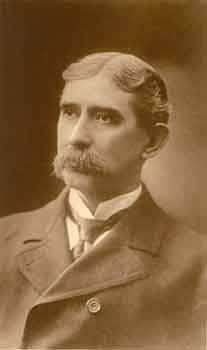
LAUDERDALE COUNTY, ALABAMA
BIOGRAPHIES
CAPTAIN LEE HOWELL
Contributed 24 Feb 2004
by
Evelyn Leinbach

Captain Lee Howell is credited with developing the railroad and bringing railroad jobs to Evansville, Indiana. He was a born-and-bred Southerner from Lauderdale County, Alabama, whose father, Phillip, was a farmer. His mother, the former Mary “Polly” Wesson, and father married in Lauderdale County on September 15, 1825. Polly was born in South Carolina and Phillip was born in Tennessee, but both came to northwest Alabama before they married.
According to daughter, Emma, Captain Lee was born on May 18, 1840. Census sources put his birth around 1842. He was one of Phillip and Polly’s eight children and their youngest son. In the 1850 federal census schedule for Lauderdale County, Alabama, he was listed as 8-year-old Levi in the Phillip Howell household.
Captain Lee started his adult career as a 15-year-old clerk and bookkeeper in the country store owned by J. G. Witherspoon in Waterloo, Alabama. The 18-year-old Levi Howell appeared in the Witherspoon household on the 1860 federal census schedule for Lauderdale County. (Captain Lee’s older brother, Benjamin, eventually married one of the Witherspoon daughters, Sallie.) In 1862 after the Civil War broke out, Captain Lee joined Captain Dick Johnson’s Company of the 4th Alabama Cavalry. He was wounded in battle at Barton Station. Before he was fully recovered from his injuries, he was detailed as clerk to Captain Swope, Brigade Quartermaster. At the close of the war, Captain Lee was given Swope’s command.
After the Civil War ended, Captain Lee together with his oldest brother, David, and another man went into the mercantile business in Eastport, Mississippi. After a year, he started his career in the packet boat business on the Tennessee and Ohio Rivers at first as a clerk and then as a master. This would have been the beginning of his lifelong association with the transportation industry. His first position was as a clerk on the steamer Rapidan, a packet boat moving between Florence and Paducah, Kentucky. According to an announcement in the Thursday, July 25, 1867, issue of the Florence Journal, Captain Lee was by then the captain of the Rapidan. He was able to save money to build two packet boats, the Rapidan 2 and the Florence Lee, which he eventually captained. The far end of the route for the Rapidan 2 and the Florence Lee was Evansville. An Evansville Daily Journal entry on August 5, 1868, stated that “Captain Lee Howell is captain of the RAPIDAN NO. 2.” There are other similar mentions of Captain Lee in the same paper over the next few years.
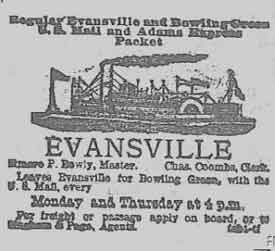
A typical packet boat advertisement
On March 28, 1867, Captain Lee Howell married Emma Ottaway of Tuscumbia, Alabama. Emma was one of four daughters born to English tailor Charles Ottaway and the former Elizabeth Garnett. The Howells had four children: Mary Garnett “Mamie” (June 18, 1868 to June 14, 1881); Lee, Jr. (May 2, 1871 to April 16, 1965); Elizabeth “Bessie” (December 14, 1872 to November 26, 1877); and Emma (August 4, 1879 to December 24, 1967).
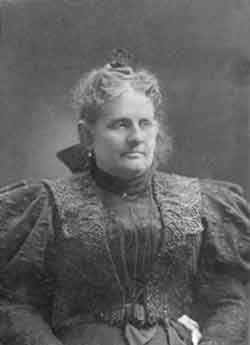
Emma Ottaway
Captain Lee began his employment with the Louisville & Nashville Railroad on April 1, 1872, as a contracting agent and ran a wagon train in the tobacco-growing section of southern Kentucky. He was hired because of his experience in transportation albeit on the waterways. Early in his tenure with the L&N, he still captained packet boats, most notably the Dick Johnson. A March 12, 1873, account in the Florence Times-Journal recounts the story of the steamer Palestine, under the command of Captain Lee and owned by the Louisville & Nashville & Great Southern Railroad, running into the pier at Danville, Tennessee, after crossing through the drawbridge. It is unknown if this mishap was a result of pilot error or the current. After striking the pier and knocking down all of the passengers, the Palestine’s stern swung around and struck the opposite pier. Everybody on board scrambled off onto the bridge, the cabin separated from the boiler deck, and the Palestine was destroyed.[1]
The generally accepted date of the Howells’ arrival in Evansville is 1880 so Captain Lee could start his position as a freight agent for the L&N after the railroad established a line between St. Louis and Nashville. They were in Evansville at the time of the 1880 federal census living at 317 Monroe. Old Evansville city directories show that the Howells lived at a few other addresses in downtown before they moved to what was to be their long-time residence in Evansville at 217 Chestnut around 1887.
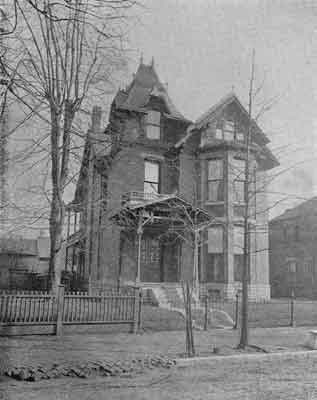
217 Chestnut Street
Two of the four Howell children did not survive to adulthood. It is unknown what Bessie died of in 1877 in Florence. Mamie died of typhoid fever in Evansville on June 14, 1881, just four days short of her fourteenth birthday. The Evansville Courier printed a lovely obituary for Mamie detailing her many fine points in the florid prose of the day. This was written probably more to acknowledge a leading Evansville citizen’s tremendous personal loss, even though Captain Lee had been officially a resident of Evansville for just more than a year. He was well known in the city before he moved there permanently because of his packet boat business.
On June 1, 1882, Captain Lee was promoted to division freight agent for the Evansville and St. Louis, and Evansville, Henderson and Nashville divisions of the L&N. On November 1st of that same year, he was made general freight agent.[2] He held this position for the rest of his life and apparently refused further promotions in the company. His efforts to build the success of the L&N in Evansville helped to create jobs at the Howell Yards. Most of these workers lived in the area of Evansville known as Howell, which was originally an incorporated town with all the amenities. In 1889, then L&N president M.H. Smith bestowed the name on the town.[3] Howell was also known as “The Little Railroad Town.”
Even with his increased responsibilities with the L&N Railroad, Captain Lee kept a hand in the packet boat industry. For a while, he was a stockholder in the Evansville & Tennessee River Packet Company and the St. Louis & Tennessee River Packet Company. During his time in Evansville, Captain Lee was a major shareholder in many businesses: The Howell Land Company; The Evansville Cross Tie Company, which merged into the T.J. Moss Tie Company; the Evansville, Ohio, and Green River Transportation Company (organized in 1889) which later became known as the Evansville and Bowling Green Packet Company. Captain Lee was still chief of the Evansville and Bowling Green Packet Company at the time of his death. He was also one of the men involved in getting the Evansville, Newburgh, and Suburban railway started and had the post of vice president until he took over as company president after F. W. Cook died. In addition to the packet boat business, he held some mining interests along the Green River. He served as a trustee for the Home for the Friendless[4] and Trinity Methodist Church.
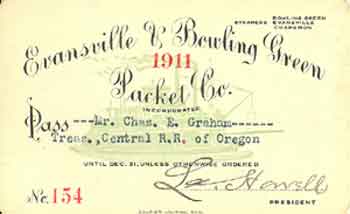
The discussion in one of Captain Lee’s biographies is rather oblique, but it appears that his early effort to better coordinate the riverboat and railroad industries was initially met with suspicion. Obviously the two ways of transportation competed with each other on one level, but there came a point where one could transport cargo more economically or practically than the other. A common activity on the river in Evansville was the transfer of cargo from river boats to railroad cars northwest of downtown. The railroad spurs are still shown on maps west of Fulton Avenue around Ohio Street at the northernmost bend of the Ohio River.
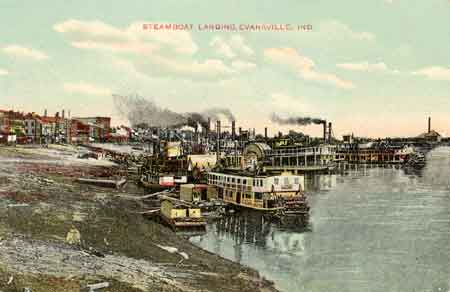
Postcard depicting Evansville wharf scene around 1910
A terrible episode in the Howell family took place in Evansville on Friday, May 3, 1912. Late that afternoon, Captain Lee’s nephew, W. T. “Teb” Howell, was captaining the towboat Kenois. Teb must have been in the employ of his uncle. He got into a dispute with William Carroll, a mate on the Lyda, at the river landing near Sixth Avenue. Apparently the Lyda’s cargo had been unloaded, and Teb Howell asked that the Lyda untie its stern so that the Kenois could land and unload its corn for further transport by the L&N. Carroll refused, and apparently Teb untied the Lyda’s stern himself.
Carroll retrieved a rifle from his cabin, and the confrontation escalated. Teb was armed with a revolver. Charles Enghoff, a Spencer County farmer who happened to be on the river bank, heard a woman screaming (probably Teb’s wife) and heard Teb ask Carroll not to shoot him in front of his wife and children. Carroll claimed that Teb had fired two shots before he shot Teb in the stomach. The police believed that Teb had indeed not fired at all, and Enghoff said that Teb’s hands were at his side when he was shot. Before the assailant jumped into a rowboat in an attempt to get away, Teb’s ten-year-old son, Terry, grabbed his father’s revolver and at shot at Carroll twice, missing him. Carroll, a 33-year-old native of Paducah, was captured soon after on the river. Teb died at 9:30 that evening with his wife and Uncle Lee at his bedside at St. Mary’s Hospital.[5] William Carroll was convicted of manslaughter the next month and was sentenced to 21 years in prison.


Lee Howell, Jr. Emma Howell
In the kitchen of the summer home of Captain Lee’s granddaughter, Emma Lee Cox Fay, an almost bat-like gnarled piece of wood used to hang. She related that her grandfather used to carry this instrument with him when he was walking around the rail yards in Evansville. One can imagine the nefarious characters that might be passing time in such a place. She said, “My grandfather was a good Christian man, but sometimes he had to get a little rough.”
Captain Lee died on January 4, 1918, of pernicious anemia at the home of his daughter, Emma, and son-in-law, J. E. Cox, on Riverside Drive in Evansville. He, his wife, and their four children are buried at Oak Hill Cemetery. An interesting side note on two of the graves concerns Mamie and Bessie Howell. Daughter Bessie was buried in the Florence City Cemetery. Mamie’s body was sent to Florence for burial after her death in Evansville. However, about two years before her 1922 death, Emma Ottaway Howell must have decided that the Howells should all be together and had the two girls disinterred and brought to Evansville for reburial. There is an account in the Florence newspaper about the Florence City Cemetery’s caretaker setting out to accompany the coffins of the two Howell daughters to Evansville. According to the article, Bessie’s coffin was opened to reveal that "[t]he body of one, a beautiful five year old girl, was in a perfect state of preservation."
Captain Lee has a connection to modern-day popular culture. He and Elvis Presley are third cousins three times removed. Their relationship is through Captain Lee’s mother’s family, the Wessons.
Evelyn Fay Leinbach
February 24, 2004
Sources:
[1] Florence, Alabama, Times-Journal, Wednesday, March 12, 1873, p. 3.
[ top ]
[2] History of Vanderburgh County, Indiana (1897), p. 451.
[ top ]
[3] Ibid, p. 230. [ top ]
[4] Ibid, p. 221. [ top ]
[5] Evansville Courier, Saturday, May 4, 1912, p. 1.
[ top ]
Return to Biographies